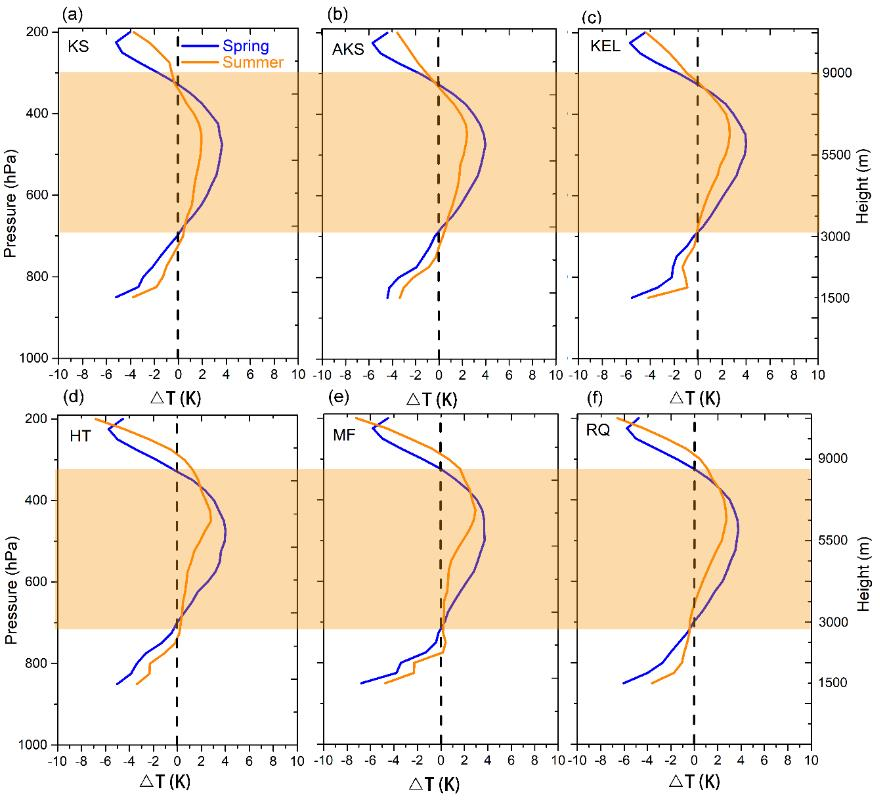
Research Highlight

Influenced by the large-scale topography of the deep basin, especially the Tibetan Plateau, coupled with strong surface heating and vigorous convective and turbulent motions over the desert underlying surface in spring and summer, the atmospheric circulation in the Tarim Basin during spring and summer exhibits unique regional characteristics. Thermal low-pressure activities are frequent, and localized dust storms occur often. During spring and summer, the Tarim Basin forms an "ultra-high" atmospheric boundary layer structure, leading to the long-term vertical existence of a "suspended" residual dust layer. Its radiative forcing can heat the basin’s atmosphere to heights approaching that of the Tibetan Plateau, inducing a "northward expansion" of the spring and summer heat source range of the Tibetan Plateau over the Tarim Basin. The characteristics of this "northward expansion" of the Tibetan Plateau’s atmospheric heat source into the Tarim Basin represent a new issue for in-depth research on regional climate change.

Figure 1. Vertical profiles of temperature differences from sounding stations in the Tarim Basin during 2016–2017; shaded areas represent the anomalous warm layer.
Utilizing sounding observation data, the Desert Boundary Layer Meteorology Research Team of the Institute of Desert Meteorology, China Meteorological Administration, has confirmed the existence of an anomalous warm layer over the Tarim Basin from an in-situ observation perspective and quantified the contribution of the "suspended" dust radiation effect to this anomalous warm layer.
The results indicate: In spring and summer, the average heating intensities of the anomalous warm layer at 300–500 hPa over the Tarim Basin are 2.53 K and 1.39 K, respectively, showing distinct spatiotemporal distribution characteristics. In terms of intensity, spring is higher than summer, but the thickness of the heating layer is greater in summer. A long-term "suspended" dust layer exists over the Tarim Basin, with the dust layer top height ranging between 3.0–5.5 km. Due to its radiative effect, the "suspended" dust layer significantly heats the atmosphere above the basin, and the heating layer almost covers the entire basin. The heating contributions of the "suspended" dust layer to the anomalous warm layer above the basin are 13.77% and 10.25%, respectively. The Tibetan Plateau acts as a heat source in spring and summer, and the heating layer over the basin resembles a northward extension of the plateau’s heat source. Therefore, this study proposes the concept of the "northward expansion" of the Tibetan Plateau heat source.
The related findings were published in Atmospheric Chemistry and Physics under the title "In-situ observation of warm atmospheric layer and the heat contribution of suspended dust over the Tarim Basin". Zhou Chenglong, Associate Research Fellow at the Institute of Desert Meteorology, is the first author of the paper, and Professor Liu Yuzhi from the College of Atmospheric Sciences, Lanzhou University, is the corresponding author. This research was jointly funded by the National Natural Science Foundation Key Project (42030612), the Chinese Academy of Sciences Strategic Priority Research Program (XDA2006010301), and other projects.
Original Publication Information::Zhou, C., Liu, Y., Zhu, Q., He, Q., Zhao, T., Yang, F., Huo, W., Yang, X., & Mamtimin, A. (2022). In situ observation of warm atmospheric layer and the heat contribution of suspended dust over the Tarim Basin. Atmospheric Chemistry and Physics, 22(8), 5195-5207.
Article Link:https://doi.org/10.5194/acp-22-5195-2022

0991-2652429

desert@idm.cn

新疆维吾尔自治区乌鲁木齐市建国路327号


Scan to follow
us on WeChat